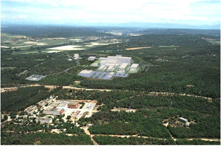February 24, 2006
Air Date: February 24, 2006
FULL SHOW
SEGMENTS
Some Like It Hot....
/ Bruce GellermanView the page for this story
Today, a special report on the once and future source of power, the atom. Einstein's theory of relativity proved that great forces could be unleashed if large atoms were split. But, even greater energies could be freed if small atoms could be fused together. Bruce Gellerman reports on the scientists who are trying to do just that. (12:30)
Cold Fusion: A Heated History
/ Bruce GellermanView the page for this story
Bruce Gellerman continues his investigation into the future of fusion with a look at the latest research in the field of cold fusion, the science of creating a nuclear reaction at room temperature. Most scientists call sustained cold fusion reactions impossible, but others say their experiments are producing energy. (18:00)
Pebble Bed Technology -- Nuclear promise or peril?
View the page for this story
A new kind of nuclear power plant is being developed in South Africa. Scientists say pebble bed technology is clean and safe, and will revolutionize the energy industry, especially for developing nations. But critics are concerned about the cost of the pebble bed reactors and about the lack of disposal plans for the radioactive waste. (15:00)
This week's EarthEar selection
listen /
download
Daybreak in the Succulent Karoo of South Africa.
Show Credits and Funders
Show Transcript
HOST: Steve Curwood
REPORTER: Bruce Gellerman
[THEME MUSIC]
CURWOOD: From NPR, this is Living on Earth.
[THEME MUSIC]
CURWOOD: I'm Steve Curwood. Fusion--nuclear fusion--is what powers the sun, and science has long sought to harness it for peaceful means.
NAGEL: So if we could tap it, we would essentially have a limitless form of energy for the planet. People come to me and say "Dave, it sounds too good to be true." Well, that's right. It is too good to be true, but that's what the promise is.
CURWOOD: Today, we look in on the ongoing efforts to tame fusion, including the controversy over cold fusion. Also, conventional nuclear power gets a boost in South Africa with plans to build smaller and, reportedly, safer reactors.
HAWLEY: Everything in the future for developing countries as we well know depends on electricity; small nuclear reactors like this are the key to the future for the world.
CURWOOD: It's the next generation of nuclear plants, and fusion--hot and cold, this week on Living on Earth. Stick around.
[NPR NEWSCAST]
[THEME MUSIC]
ANNOUNCER: Support for Living on Earth comes from the National Science Foundation and Stonyfield Farm.
Some Like It Hot....
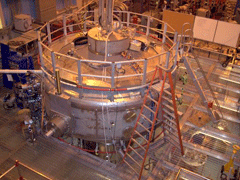
The Levitating Diapole Experiment at MIT is designed to achieve fusion, or the energy of the stars, on Earth. (Photo: Bruce Gellerman)
CURWOOD: From the Jennifer and Ted Stanley Studios in Somerville, Massachusetts, this is Living on Earth. I'm Steve Curwood.
Today, a special report on the once and future source of power, the atom.
[MUSIC: Bohumir Kryl "Oh Promise Me (1905)" from 'The Black Wax Sampler, 1902-1912: Wax Cylinder Phonograph Recordings' (Tin Foil - 2001)]
CURWOOD: We begin a hundred years ago when, at the age of 26, Albert Einstein came up with the radical notion that would forever change our concepts of time, space and the link between mass and energy.
EINSTEIN: The equation e is equal to m c-squared, in which energy is put equal to mass, multiplied by the square of the velocity of light, showed that very small amounts of mass may be converted into a very large amount of energy and vice versa.
CURWOOD: Einstein's Theory of Relativity told us that great forces could be unleashed if large atoms were split, and even greater energies freed if small ones could be fused together. Large atoms like uranium naturally fall apart, decaying with radiation, so it didn't take scientists long to figure out how to ignite that process, and explode a bomb or run a power plant. But it's much harder to fuse atoms together in the continuous way the sun turns hydrogen into helium.
Bruce Gellerman has our report on the people who are trying to do just that.
GELLERMAN: It's easy to see why many scientists say fusion is the energy source of the future. The primary fuel is a form of hydrogen called deuterium, and scientist Michael Swartz says there are oceans of it.
SWARTZ: In every cubic mile of sea water is enough deuterium to produce equal energy to all the earth's reserves. So if we can tap it, we would essentially have a limitless form of energy for the planet.
GELLERMAN: Not only that, fusion is virtually non-polluting. There are no greenhouse gases. And the waste product is helium, the stuff in toy balloons.
SWARTZ: What it offers is a chance to power the United States with an economy that does not produce pollution.
GELLERMAN: Sound too good to be true? Well, that's the promise physicists have been making since they began work on fusion in the 1950s. And they have come up with two very different visions of fusion's future: one hot, one cold.
We'll have more about cold fusion later. But first --
[DOOR OPENS]
GELLERMAN: Earl Marmar , a senior scientist at MIT, unlocks a door mainstream physicists say is the surest route to fusion energy.
MARMAR: So, this is our control room...
GELLERMAN: Inside Marmar's laboratory, researchers huddle over banks of computers. There are video monitors everywhere.
MARMAR: This is where the scientists, the students and engineers hang out when we're actually operating an experiment which we are today. Today's a run day.
GELLERMAN: This lab looks and sounds like the control room at a lunar space launch.
[COUNTDOWN...10-9...]
GELLERMAN: But physicists here are aiming higher than the moon..
[...8-7-6....]
GELLERMAN: They want to create the power of the stars.
[...5-4...ENTERING PULSE...MACHINE YAWNS]
GELLERMAN: Thirty times a day, four days a week, Earl Marmar and his team of scientists send a pulse of electric current through the experimental fusion reactor they call Alcator C Mod. And, for a few brief moments, they create energies found only in the stars.
COUNTDOWN VOICE: Entering recool.
GELLERMAN: So, that's it?
MARMAR: That's it, yeah, that was a successful shot. We had a nice two second pulse, and now we're going to study what happened on that pulse.
GELLERMAN: So, you went to 60 million degrees in there?
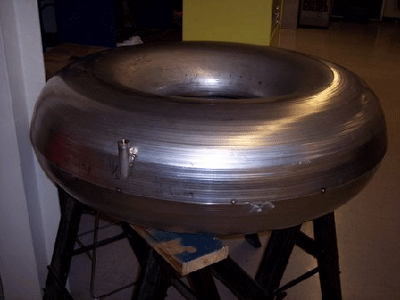
This superconducting magnetic ring weighs half a ton and will levitate inside the LDX to produce a huge magnetic field. (Photo: Bruce Gellerman)
GELLERMAN: The 100 ton Alcator C Mod experimental fusion reactor is exciting science, as big and as expensive as it gets on the MIT campus. Alcator is a 4th generation Tokamak design. The name is a Russian acronym describing the shape: Tokamaks look like giant stainless steel donuts. There are about 20 in the world. This one here at MIT is the most advanced.
GELLERMAN: So can you show me the machine?
MAMAR: Well, actually, it's locked up. Because when we're operating we don't allow people to go out there and look at it. It's about 50 yards in that direction, through those doors and then another big five foot thick concrete door.
GELLERMAN: The concrete door protects workers in the control room from getting zapped by high energy neutrons produced when Alcator C is up and running. But compared to fission reactors -- which use uranium -- fusion reactors like Alcator are safer. It produces one-millionth of the radioactive waste and there's no chance of a meltdown.
MAMAR: Can't happen. No, there's so little fuel in these devices, an uncontrolled reaction isn't possible. It's so hard to make fusion happen. You don't have to worry about that.
GELLERMAN: The reason it's so hard to make fusion happen is easy to understand. Take two toy magnets and try to get the like poles to stick together. You can't because like charges repel. It's the same thing with fusion. The nuclei of the deuterium fuel are positively charged and getting them to fuse requires huge amounts of energy. In the center of stars, gravity does the job.
On Earth, physicists reproduce a star's gravity by surrounding their Tokamak donuts with powerful magnets. Alcator C mod has three of them. The force field squeezes the deuterium atoms tighter and tighter until the electrons are torn away, leaving the nuclei to zip around the donut at a thousand miles a second, colliding and fusing and creating temperatures in the hundreds of millions of degrees.
GELLERMAN: How do you get your data? Why don't your instruments melt?
MARMAR: Well, the instruments aren't inside the plasma, they're outside.
GELLERMAN: Something's gotta be sensing it.
MARMAR: Yeah, that's visible light. That's coming out on the plasma so it comes through a window and goes into a TV camera , a fancy TV camera, but it's a TV camera.
GELLERMAN: The trick is controlling the turbulent fuel in the reactor -- keeping the nuclear particles away from the walls of the donut where they rapidly cool. The ultimate and, so far, elusive goal, says Earl Marmar, is a sustained reaction -- one that produces more energy than it takes to trigger it.
MARMAR: Right now, Tokamaks generally run in a pulse mode. For example, for us it's a few seconds; some of the bigger machines can run for tens of seconds. But in the end we want to a reactor to be running steady state.
GELLERMAN: Building a fusion reactor that can run steady state for six minutes...Device that can sustain a fusion reaction was final, now seems within reach, possibly.
That's a thermonuclear reaction that once ignited runs on its own. In the summer of 2005, after more than a decade of heated negotiations, the U.S., the EU, France, Russia, South Korea, China and Japan decided the path to a steady state reactor would be: ITER, it's an acronym for the International Thermonuclear Experimental Reactor. ITER is designed to demonstrate the technical and scientific feasibility of fusion based upon the Tokamak design.
|
Construction is set for 2006. And when it's finished, ITER is expected to produce 400 megawatts of fusion energy for more than six minutes. That's twice as much energy as it needs to jumpstart the reaction and 25 times as much energy as today's most powerful Tokamak.
Ray Orbach, director of the U.S. Energy Department's Office of Science, was at the Moscow press conference when it was announced that ITER would be built in the south of France.
ORBACH: The excitement we feel is that's a design goal. But there is every possibility that we would get four times that amount by lets the end of operating period, say 10 years after operations began. If we can do that, we're within shouting distance of what a commercial power plant would require.
GELLERMAN: Orbach says, faced with the threat of global warming produced by burning fossil fuels and the ever-rising demand for oil, the future of the planet depends on ITER's success. But he admits it's a gamble.
ORBACH: Remember, this is a burning plasma that has never been constructed before, and it's a challenge.
GELLERMAN: In time, and with enough money, a fusion reactor is technologically feasible. But will it ever make financial sense?
GARWIN: I'm quite confident that we'll have fusion energy, more energy out than we put in.
GELLERMAN: Physicist Richard Garwin is IBM fellow emeritus at the Watson Research Center, winner of the nation's highest science honor.
GARWIN: Whether that will be economical in comparisons with other sources of energy is another question. That's a very big question.
GELLERMAN: In the mid-1990s, Congress raised the same question and didn't like the answers it was getting from physicists. Despite major advances in understanding the complexity of fusion, lawmakers were frustrated by the slow progress physicists were making. The Clinton administration had pulled out of the ITER project, drastically cut funding for Tokomak research, and then went looking for alternative methods for achieving fusion. No idea was deemed too far out. Not even Jay Kesner's.
KESNER: About 10 years ago I got interested in a new approach to fusion different from the mainstream.
GELLERMAN: Jay Kesner, a senior scientist at MIT, calls himself one of the kooks in the plasma fusion field. Kesner came up with a radical design for a fusion reactor, finding inspiration in the heavens.
GELLERMAN: This thing looks like a flying saucer.
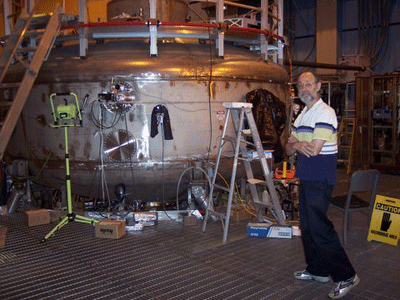
Senior scientist Jay Kesner stands next to the Levitating Diapole Experiment at MIT. (Photo: Bruce Gellerman)
KESNER: Yeah, before we put the floor in it, it looked like a lunar lander.
GELLERMAN: Jay Kesner stands next to what he calls his levitating dipole experiment. Ten feet high, and 18 wide, the device looks like a giant, squished stainless steel pumpkin. Actually, the LDX is modeled after the planet Jupiter. Why Jupiter? Well, in the 1980's astrophysicists made a surprising discovery. A flyby voyage of Jupiter revealed its magnetic field controlled a huge, dense plasma, nearly perfect for fusion. Kesner is trying to duplicate the feat. But in order to pull it off he had to use a magicians trick: levitation. Suspended inside the LDX vacuum chamber is a half-ton magnet.
KESNER: So, it's like taking a planet and making a big hole in the middle so that the magnetic field lines don't hit the planet. And that's exactly why we want to have a magnet that has a hole in the middle, that looks like a bagel. That's sitting there free in space, and you want it to be sitting floating freely because supports will scrape off the plasma.
GELLERMAN: And that would prevent fusion. At six million dollars, the LDX is the cheapest and simplest fusion device yet conceived. And, potentially, it could operate more efficiently at lower temperatures than the far more expensive and complex Tokamaks.
Sustaining a steady state fusion reaction would be a technological tour de force, but sustaining a steady flow of research funds has proven even more difficult. Ninety-five percent of the research money comes from the federal government, and Miklos Porkolab, director of MIT's Plasma Science and Fusion Center, says the half-life of Washington's interest in fusion is short.
PORKOLAB: If we had gotten the money 30 years ago, what we asked for to develop fusion, then we would probably have it now working. But we never got the money. We got one third. You can't achieve fusion if you don't give the funding to build the devices that we need.
GELLERMAN: Scientists say their goal is a commercial fusion reactor by 2050. But in the past their predictions have been overly optimistic and the goal line keeps moving. In the 1950s, physicists predicted they'd have a fusion reactor by 1970. Then it was 1990, leading critics to quip there's a new constant in phsyics: fusion in 20 years. Robert Park writes a column for the American Physical Society dedicated to debunking scientific claims.
PARK: The joke is that fusion is the energy source of the future, and always will be.
CURWOOD: And one way forward may involve going back to the future. In just a moment, Bruce Gellerman continues our report on fusion with an update on the technology that first thrilled, then chilled, the scientific community back in the 1980's--cold fusion. Stay tuned to Living on Earth.
[MUSIC: Aqueduct "Tension" from 'I Sold Gold' (Barsuk Records -- 2005)]
Related links:
- MIT's Plasma Science and Fusion Center
- International Thermonuclear Experimental Reactor
Cold Fusion: A Heated History
CURWOOD: It's Living on Earth, I'm Steve Curwood, and our investigation into what could be a major energy source of the future continues at a recent meeting at the Massachusetts Institute of Technology.
[SOUND OF MEETING]
CURWOOD: This seems like any one of the hundreds of gatherings that take place each year on MIT's campus.
NAGEL: Just walk in and listen. You cannot tell that you are anywhere but a scientific conference.
[TAPE: Though it's not related technically.]
CURWOOD: There are some of the best minds in the country discussing cutting edge science.
SWARTZ: I have two doctorates, one in medicine from Harvard and a doctorate in electrical engineering from MIT.
CURWOOD: Presenting their latest research.
NAGEL: These are skilled people who have done careful experiments and calculations, who stand up and tell you what they've done and what they've found, they respond to all your questions. They publish the information, they respond. This is an area of scientific research.
CURWOOD: And, of course, there are venture capitalists investigating the science, seeking to catch the wave on the next big thing in technology.
MALE: Clearly, there have been many advances on both the theoretical level and there are people who have experimental results that require attention.
CURWOOD: But what separates this conference and this crowd is the field they're investigating. It's cold fusion. And while few scientists are willing to accept it as a proven phenomenon, its advocates say it could provide vast amounts of non-polluting energy.
SWARTZ: It offers a chance to have the United States make the Kyoto agreement moot, and make greenhouse warming moot.
CURWOOD: What has been called "the most enormous conflict in basic science of the 20th century" began on March 23, 1989.
ROBERT SIEGEL ON ALL THINGS CONSIDERED: Scientists in Utah today made an extraordinary claim. They announced that they've created fusion energy at room temperature in a simple test tube.
CURWOOD: Cold fusion was soon being hyped and hailed as the greatest discovery since fire, and, almost as soon, it was being assailed by critics as a hoax. Bruce Gellerman reports on what went wrong and what might be right about cold fusion.
GELLERMAN: Looking back, it's easy to see how a series of blunders nearly doomed cold fusion from the start. The first mistake, science by media circus.
NEWSCAST: We are here today to consider the implications of a scientific experiment....
GELLERMAN: Reporter questions are no match for scrutiny by fellow scientists, but University of Utah officials didn't want to follow standard scientific procedures and first publish the discovery in a scholarly journal. They were afraid someone would steal it so they hastily held a press conference. At times, the announcement seemed more like stand-up than scientific method
FLEISCHMANN: It's a pretty big kitchen (LAUGHTER)
GELLERMAN: Dr. Martin Fleischmann was clearly enjoying himself. And why not? He was possibly the greatest electrochemist of his day, and after five years of working in secret, in a basement laboratory with Stanley Pons, chairman of Utah's chemistry department, cold fusion was easily his greatest discovery.
FLEISCHMANN: Stan and I thought this experience was so stupid that we financed it ourselves.
GELLERMAN: As relaxed as Martin Fleischmann was, Stanley Pons was nervous. He had published 150 scientific papers, but now he didn't even have time to prepare notes. At the podium, Pons almost dropped the experimental cold fusion device he and Fleischmann had developed.
PONS: Basically, we've established a sustained nuclear fusion reaction by means which are considerably simpler than the conventional techniques. And with this process there is a considerable release of energy and we've demonstrated it can be sustained on its own. In other words, much more energy is coming out than we're putting in.
GELLERMAN: Pons and Fleischmann claimed their fusion device generated four times more energy then they put in. The extra heat they got out was hundreds of times more energy than any chemical reaction could have possibly produced. And all it took, they said, was some basic laboratory equipment. A battery, an electrode made out of the metal palladium, and a test tube filled with heavy water -- that's water made from a form of hydrogen called deuterium.
When the scientists passed an electric current through the palladium, the electrode absorbed the deuterium like a sponge. For two months Pons and Fleischmann loaded the palladium with so much deuterium the electrode bulged, squeezing the deuterium nuclei closer and closer together.
FLEISCHMANN: The experiment is very simple, and under those circumstance we have found conditions under which fusion takes place and can be sustained indefinitely. We have run the experiment hundreds of hours...
GELLERMAN: The media was abuzz with stories about "hot energy from cold fusion." Congress and the president wanted answers. The Soviet Academy of Sciences even offered to set up a cold fusion research center. Soon researchers around the world were announcing they, too, were able to create cold fusion...but only once in a while. Sometimes the experiment worked, most of the time it didn't. It seemed cold fusion was a fickle phenomenon. Even Pons and Fleischmann could only get it to work one out of ten times.
GARWIN: The more you looked into their results the less there was, unfortunately.
GELLERMAN: Physicist Richard Garwin, IBM fellow emeritus at the Watson Research Center, was one of the first to investigate the cold fusion claims.
GARWIN: If one had that energy, that would be great. And I would be the first one to cheer. But why can those people not reproduce the energy that they get?
GELLERMAN: The ability to reproduce an experiment is the gold standard in science for verifying a discovery. But a large share of the blame why researchers weren't able to reproduce the results was Pons and Fleischmann's, and accounts for their second and third big mistakes.
The experiment they described as simple to do was anything but, and they had kept critical experimental procedures a secret.
Then there was the fourth and near fatal mistake. In hot fusion, like the sun, the reaction gives off byproducts: high energy neutrons, tritium, and helium. Pons and Fleischmann reported finding these reaction byproducts, but scientists skeptical of their claim said the levels were so low they were beyond belief.
The final blow came when Fleischmann made a sophomoric error. He miscounted the neutrons. One of the first to realize the mistake was Richard Garwin.
GARWIN: It turned out that Fleischmann and Pons didn't really understand anything about nuclear measurements, so all that was wrong. Anybody can make a mistake and Fleischmann made several.
GELLERMAN: The official burial came in mid-summer when a committee convened by the Department of Energy concluded there was no convincing evidence Pons and Fleischmann's experiment generated extra heat, or was a nuclear reaction, and the committee saw no reason to set up a special fund to investigate the claims.
Their reputations ruined, and their discovery disgraced, cold fusion became the third rail of science. Stanley Pons gave up his American citizenship and joined Martin Fleischmann in self-imposed exile in France.
[MEETING SOUNDS]
GELLERMAN: But reports of the death of cold fusion were premature. The field was kept alive by a small community of researchers who meet every 18 months or so. Critics call them a cult, but these true believers are sustained by laboratory results they say prove cold fusion can produce unlimited, safe, non-polluting energy.
NAGEL: People come to me and say "But Dave, it sounds too good to be true." Well, yes, it is too good to be true, but that's what the promise is.
GELLERMAN: Dave is David Nagel. Now research professor at George Washington University, Nagel retired as a senior scientist at the Naval Research Laboratory. The U.S. Navy was one of a number of government departments that continued to investigate cold fusion even after it had been all but forgotten in the academic world.
NAGEL: Well, it is a legitimate scientific area. It's certainly not alchemy. And the answer to the question about energy production, is emphatically yes. There are over 3,000 papers in this field and hundreds of them have reported net energy gain, and there are a handful that will survive scrutiny by anyone in terms of everything you want in science.
GELLERMAN: Cold fusion advocates say more than 20 laboratories in seven countries have successfully replicated the original Pons and Fleischmann experiment.
ATTENDANT : We're standing now outside the door of the principle laboratory...
GELLERMAN: One of the first scientists to try to repeat the experiment was Dr. Michael McKubre.
ATTENDANT: You can enter and I'll show you what's inside.
He's director of Energy Research at SRI International in Menlo Park, California. On his first attempt it took McKubre a month just to get the reaction going.
McKUBRE: It was then another month before we had coaxed and tweaked and pushed this experiment to the point that it gave some glimmerings of excess heat. That experiment produced three episodes of excess heat in the two months of operation of that experiment.
GELLERMAN: But it was only after three or four years of doing cold fusion experiments that Michael McKubre says he was convinced the excess energy he was measuring in his experiments was real.
McKUBRE: The heat that we're measuring consistently since 1989 is at least ten times, in some cases a hundred times or a thousand times larger than the sum total of all chemical reactions that could take place inside the cells. So on that basis alone you have to say to yourself "this is probably nuclear" but you can't make a claim for a nuclear effect without having some products in hand. So we set out to look for products.
GELLERMAN: Finding the byproducts of fusion -- such as helium, neutrons and radiation -- has been the holy grail of cold fusion scientists. But researchers have had difficulty detecting them, their results inconsistent and the amounts still way too low, say critics, to be from a fusion reaction.
But Michael McKubre says he has proof-positive fusion is happening. He's detected helium in nearly the exact amount theory says should be there, and also tritium, a rare, radioactive form of hydrogen.
GARWIN: They've been very careful there, but there are mistakes.
GELLERMAN: In 1993, Richard Garwin inspected Michael McKubre's lab on behalf of the Department of Defense.
GARWIN: The data was not carefully preserved, things were not dated, there were only two positive runs as I recall, and one of them turned out to be a misconnection of the cell. Unless you can reproduce the results, you can't say you have them.
GELLERMAN: But now U.S. Navy scientists say they do have them. They claim to have verifiable, irrefutable proof cold fusion is real, despite critics who say it's simply impossible.
BOSS: We just keep plugging along. You've gotta have a thick skin to be in this field.
GELLERMAN: Dr. Pamela Boss works at the Space and Naval Warfare Systems Center in San Diego. She and Dr. Stanislaw Szpak have produced some of the most definitive evidence of the cold fusion phenomenon. They fund the research mostly out of their own pocket and, even though he's retired, Dr. Szpak still comes in almost every day to conduct cold fusion experiments, perfecting a method that he says speeds up the reaction. Now, instead of waiting weeks for cold fusion to begin, it happens instantaneously.
SZPAK: Now we have 100 percent reproducible results. In other words, we always get to that last step. We are doing that within seconds. But there is one thing that we need to concentrate is what are the conditions that lead to the last step before the nuclear reaction?
GELLERMAN: Like Michael McKubre, Szpak and Boss have measured elevated levels of tritium and have focused on detecting the other radiation byproducts of fusion reactions, gamma and x-rays. Pamela Boss:
BOSS: We work with a lot of physicists here and they, of course, were very skeptical. So then, we borrowed equipment to do gamma ray measurements and x-ray measurement. And you could see they were tracking one another. When the gamma ray detector was going up, so was the x-ray detector. And I pointed this out to the physicist who was helping us and he was a little bit disturbed by that because he made sure that everything was on separate circuits, there was no cross talk.
GELLERMAN: But the most dramatic experimental evidence Boss and Szpak have that cold fusion is a nuclear reaction is a medieval alchemist's dream come true. But instead of turning lead into gold, they say they have images of minute nuclear explosions turning parts of their palladium electrodes into aluminum, magnesium and zinc.
SZPAK: We see appearance of elements which weren't there to start with. In other words, during the experiment itself these elements have been created. Now, by what mechanism, if you're asking me that question, I cannot answer because I simply don't know yet.
GELLERMAN: Well, what are the possibilities other then cold fusion?
SZPAK: Oh, no, no, no. It's a nuclear reaction at room temperature.
GELLERMAN: Szpak and Boss have published the results of their experiment in a prestigious, peer-reviewed physics journal. And Japanese scientists have reported similar findings. So, how might cold fusion work? Well, few researchers at U.S. universities are investigating the question because it's a career destroyer; those who study cold fusion do so at their own peril. One of the few who has from the very beginning is Peter Hagelstein of MIT.
HAGELSTEIN: This experiment implied the existence of some new physics. Hence, if there's going to be heat there are going to be neutrons; if there's no neutrons hence there's no heat, hence it's all wrong. It got very confused very quickly.
GELLERMAN: Today, because of his continued work on cold fusion, Peter Hagelstein lives a life of virtual academic exile at MIT. He lost funding for his lab and he never did make full professor.
[SOUND OF WRITING ON BLACKBOARD AND HAGELSTEIN TEACHING]
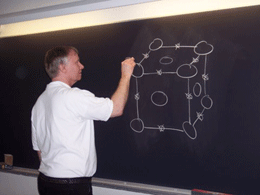
Professor Peter Hagelstein of MIT draws a diagram illustrating cold fusion theory. (Photo: Bruce Gellerman)
GELLERMAN: Over the years, Associate Hagelstein has come up with 150 versions of a theory trying to explain how cold fusion could create a nuclear reaction at room temperature without high levels of fusion byproducts. Now, he thinks he has it. On a blackboard in an MIT classroom he slowly sketches what looks like a box spring.
HAGELSTEIN: People drew pictures something like this picture and looked to see where the deuterium was and they calculated how likely it is that one deuteron would talk to a neighboring deuteron.
GELLERMAN: As he maps out the molecular structure of palladium, Dr. Hagelstein seems to stare through the blackboard into space. It's as if he had entered the through-the-looking-glass sub-atomic world that is quantum mechanics. It's a different universe from the one you and I live in where, theoretically, it's possible to be in two places at the same time.
HAGELSTEIN: The corners fit in like so, and there's on that fit's in the middle here...
GELLERMAN: As Peter Hagelstein sees it, cold fusion is not just a colder version of plasma or hot fusion, but an entirely different phenomenon. His theory doesn't violate any of the fundamental laws of nature. But it does require a rethinking of modern physics.
HAGELSTEIN: So, we start out now with a picture of a communication between reactions at different sites, and this is not in the textbooks.
GELLERMAN: When you show this to your colleagues do they go, yeah, I got it, that's it.
HAGELSTEIN: No, generally they say "Hagelstein, you're as mad as a mad hatter" or something. But some are intrigued. But, at the moment, it remains a conjecture.
GELLERMAN: In 2004, 15 years after the Department of Energy first rejected claims of cold fusion, Drs. Hagelstein, David Nagel and Michael McKubre convinced the DOE to reconsider and review the latest laboratory evidence. An anonymous panel of 18 experts was convened. Half of the members concluded there was convincing evidence that excess heat was coming out of cold fusion experiments, and about six of the experts said the phenomenon might well be caused by a nuclear reaction.
Still, half the panel called the claims preposterous, the theories implausible and the phenomenon impossible, requiring multiple miracles to occur.
Over the years, the most outspoken critic of cold fusion has been Robert Park, author of the book "Voodoo Science." He calls cold fusion an illusion -- nothing more than wishful interpretation of data by researchers.
PARK: I've never seen anything quite like cold fusion. It's an interesting phenomenon. I don't know how to explain it either, but after this much time if they haven't come up with anything more convincing than that, if everybody is not bowled over by their experiment this time...I guess I'm still skeptical.
GELLERMAN: A healthy skepticism is at the heart of the scientific method, but it underscores the fact that while scientists try to impose objective procedures and processes in the way they conduct their experiments, science is fundamentally a human endeavor. That's why two skilled scientists can conduct the same experiment, look at the same things, and come to very different conclusions. Even something that's seemingly as simple as measuring whether there's excess heat coming out of a test tube.
History can offer solace, of sorts, for cold fusion advocates. In 1905, Albert Einstein came up with his revolutionary theory e=mc2, it laid the basis for nuclear energy. But it wasn't until 27 years later, in 1932, that scientists in the lab finally confirmed his theory. By that measure, cold fusion still has time before it's fully recognized, or finally rejected, by the ultimate arbiter in these matters: the scientific method.
[MUSIC: Autechre "Nine" from 'Amber' (Warp Records -- 1994)]
GELLERMAN: For Living on Earth, I'm Bruce Gellerman.
Related links:
- Low Energy Nuclear Reactions (cold fusion)
- New Energy Times
CURWOOD: While science tries to figure out how to make hot and cold fusion work, the energy crisis and concerns about global warming are breathing new life into the technology of nuclear fission reactors that rely on the splitting of atoms, rather than the fusing of them. And in South Africa they are rolling out a new generation of nuclear reactors. They're called "pebble beds" and to find out why keep listening to Living on Earth.
ANNOUNCER: Support for NPR comes from NPR stations, and: The Charles Stewart Mott Foundation, online at m-o-t-t dot org, supporting efforts to promote a just, equitable and sustainable society; The Kresge Foundation. Building the capacity of nonprofit organizations through challenge grants since 1924. On the web at k-r-e-s-g-e dot org; The Annenberg Fund for excellence in communications and education; and, The W-K Kellogg Foundation. 'From Vision to Innovative Impact: 75 Years of Philanthropy; This is NPR, National Public Radio.
[MUSIC: Secret Chiefs 3 "The End Times" from 'Book of Horizons' (Web Of Mimicry - 2004)]
Pebble Bed Technology -- Nuclear promise or peril?
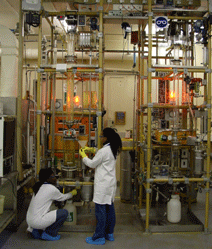
The kernel laboratory of the experimental pebble bed modular reactor. (Photo courtesy of Pelindaba Labs)
CURWOOD: It's Living on Earth, I'm Steve Curwood. Fusion energy could be decades away, but there's a new type of fission energy that may be just over the horizon. And it comes from a place you might not expect.
[BIRDS AND OUTSIDE AMBIENCE]
CURWOOD: Amid the songbirds and acacia trees of South Africa's high hill country, there's a sprawling complex of brown concrete buildings.
[CAR DRIVES BY. CROSSFADES TO VENTILATION SOUNDS]
CURWOOD: Special air shafts are a tip-off to what goes on inside.
VENTER: The ventilation is specifically designed for working with uranic materials. There are no windows open to the atmosphere here. And you can operate these big areas under a negative pressure, meaning that any leakages would be air coming in and not potentially contaminated air leaking out. When you work with uranium, you have to work clean.
CURWOOD: Fanie Venter is a soft-spoken engineer who's developing a new type of atomic fuel at the Pelindaba Labs.
[VENTILATION; SQUEAKY DOOR]
CURWOOD: His facility has a cloak-and-dagger quality to it. We enter through the bathroom.
VENTER: These buildings, having been built at a time when the programs were of a strategic nature and rather secret, you will only find change rooms for men and women. You don't find separate ones for visitors.
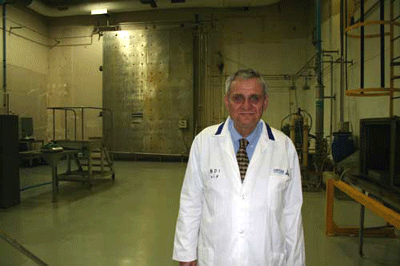
Dr. Fanie Venter manages a team of research scientists who are engineering a new type of fuel for the pebble bed modular reactor project. (Photo: Steve Curwood)
[CORRIDOR SOUNDS]
CURWOOD: During apartheid, parts of Pelindaba were filled with scientists enriching uranium for an atomic bomb. That ended as Nelson Mandela took office more than a decade ago. But the labs here are busy again, with technicians working to make a different kind of nuclear power for South Africa.
[SOUND OF MOTOR]
CURWOOD: The process begins with a tube of bubbly yellow liquid, and a chemical engineer named Annaleen Müller.
MULLER: This is the kernel laboratory, where we manufacture the uranium part of the fuel for the reactor. Okay, you can come and have a look.
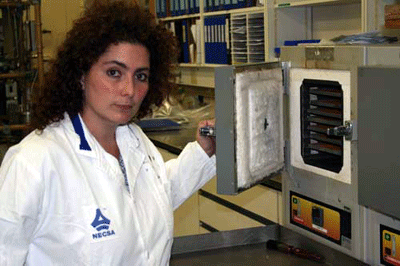
Annaleen Muller dries trays of uranium kernels in a laboratory oven. (Photo: Steve Curwood)
[BUZZING CONVERSION MACHINE]
CURWOOD: Müller converts uranium powder into fuel kernels by dropping it through a bath of ammonia.
MULLER: As the droplet comes out of the nozzle it forms a very soft round droplet. And you might know ammonium diuranate, or ADU, which is well known as yellow cake. So, basically, we are making round little balls of yellow cake.
CURWOOD: They look like tiny little peppers, or tiny mustard seeds.
MULLER: Yes. We'll produce a few million of these kernels during one day's production.
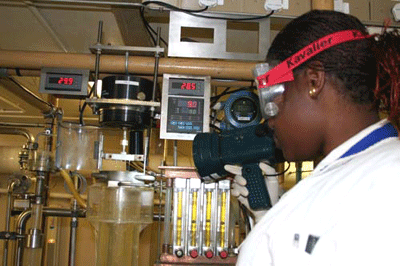
Technicians monitor the formation of "yellow cake" uranium fuel kernels inside the Pelindaba research laboratories in South Africa. (Photo: Steve Curwood)
[PRESS SOUNDS]
CURWOOD: What happens next is what engineers believe will launch a whole new generation of nuclear power. Several thousand kernels are pressed together inside a graphite and ceramic shell.
[PRESS SOUNDS]
CURWOOD: The result is fuel pebble.
[PRESS SOUNDS]
CURWOOD: Can I feel one of these things?
[CURWOOD HOLDS PEBBLE]
CURWOOD: Ah, not very heavy.
VENTER: It's completely round, about the size of a tennis ball.
CURWOOD: Or you could put it on a pool table perhaps and get away with it as a billiard ball. Except it's, well, it's the color of pencil lead, graphite. Humph. Seems all very simple.
[PRESS SOUNDS]
CURWOOD: These test pebbles are made with depleted uranium, so they're safe to handle. But Fanie Venter hopes to make the real thing soon. He says pebbles are the fuel of the future for a new type of atomic station called a pebble bed modular reactor.

Different stages of uranium kernels that go inside the core of the fuel pebble. (Photo courtesy of Pelindaba Labs)
VENTER: The pebble bed reactor is a nuclear reactor where the fuel is in the form of a sphere. And heat flows out of the fuel sphere, and there's helium that comes through the reactor. And it's heated helium that is used to generate electricity.
CURWOOD: So, what's revolutionary about this?
VENTER: It's completely safe because we're talking about ceramic fuel elements. It contains no metal parts. And even if there was a loss of coolant in the reactor, the fuel cannot over heat to the point where you have a meltdown of the fuel sphere.
[LAB SOUNDS]
CURWOOD: The pebble bed concept comes from Germany where experimental plants ran for several years. Now, after a decade of refinements, the South Africans are commercializing the design. They claim the technology is ready for worldwide distribution. The big question is whether the world is ready for a nuclear resurgence.
[LAB SOUNDS; CONFERENCE CROWD SOUNDS]
KRIEK; Welcome: Distinguished guests, ladies and gentlemen, welcome to this historic milestone.
CURWOOD: To build support for the pebble bed initiative, the project invited 350 visitors to South Africa's capital, Pretoria, for a first-of-its-kind international conference.
[VIDEO MUSIC BEGINS: DRUMMING]
CURWOOD: People from 16 countries came to see if they should get involved by supplying parts or services.
[VIDEO NARRATION: South Africa: land of beauty, land of diversity.]
CURWOOD: Video presentations portrayed South Africa's nuclear ambitions as a patriotic turning point for a young democracy...
[CLAASSEN: This project affords a unique opportunity... ]
CURWOOD: ...and the project's key engineers stressed how a pebble bed modular reactor--a PBMR--will be different from today's nuclear plants. Gert Claassen explained they'll be much safer and smaller. And they'll be pre-fabricated in a factory for quick assembly in the field. This will be a major change for the nuclear industry because most existing plants were large, expensive, one-of-a-kind designs.
CLAASSEN: Because PBMR is designed on a modular basis, it affords us the opportunity to say to all the clients that you will buy a standard unit. Today, if you buy a Boeing airplane, you can change the color of the seats and one or two other things, but you buy a standard Boeing aircraft. And that is exactly what PBMR will do.
CURWOOD: This conference featured international experts who claim pebble bed reactors will be part of a global nuclear renaissance. Regis Matzie is chief technology officer with Westinghouse Electric.
MATZIE: When I first got into nuclear energy, we were selling between 30 and 50 reactors a year in the United States. And then it rapidly went down to basically zero. So what we're seeing today is the start. Once we see new plants built in the United States, the Chinese program, the Korea program, the Japanese program. I think you're gonna see a renaissance in Europe, it's just waiting to happen. I think we're gonna see in the next decade what I saw when I started in the industry.
ION: Yeah, I think we're seeing a step change, a paradigm shift, which is great.
CURWOOD: Sue Ion is the technology director for British Nuclear Fuels. She thinks nuclear energy is becoming more attractive because of the growing concern over greenhouse gas emissions from coal-fired power plants. Ms. Ion also says pebble beds have an added benefit that can move them beyond the electricity business. The reactors will operate at extremely high temperatures -- not hot enough to melt the fuel, but hot enough to efficiently desalinate ocean water for drinking. And actually so hot they could crack open molecules of water. That would make it possible to manufacture hydrogen.
ION: When you look to the future, when we want clean means of transportation, where we want to power our cars with something other than gasoline and look to the possibility of fuel cells and hydrogen as a fuel for them, we have to create the hydrogen cleanly. And technology like the pebble bed technology will help us to generate that hydrogen cleanly.
CURWOOD: PBMR engineers are looking primarily to the developing world where urbanization and industrialization are creating tremendous demand for electricity. Robert Hawley, a consultant who used to run the UK's nuclear program, thinks that's wise.
HAWLEY: For a long, long time we've been unable to apply nuclear to developing countries because we couldn't really economically produce small nuclear reactors. The pebble bed fits into that because without electricity you can't have education, you can't keep your food cool, you can't pump water, you can't purify water. So everything in the future for developing countries as we well know depends on electricity. And there's 40 percent of the world without electricity, they've got to have it. Small nuclear reactors like this are the key to the future for the world.
[CONFERENCE CROWD SOUNDS]
CURWOOD: This conference generated the international buzz the organizers were seeking. The pebble bed project has been financed by the South African government's Industrial Development Corporation and the state utility Eskom, along with British Nuclear Fuels. They're confident they'll be ready to construct a demonstration reactor near Cape Town in 2007. They expect South Africa will take at least 20 units from the assembly line starting in 2013, and other countries will buy at least 75 more over a 15-year period. But not everyone in South Africa thinks this is a good idea.
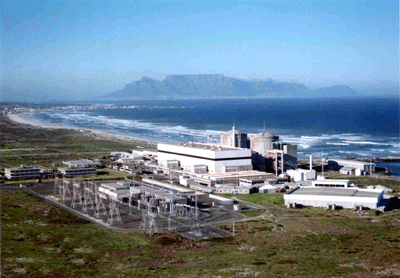
Engineers plan to build a pebble bed test reactor beside Africa's only existing nuclear power plant, the Koeberg station, on the Atlantic coast near Cape Town. (Photo courtesy of Eskom)
WORTHINGTON: In terms of this hype about a nuclear renaissance: well, the nuclear industry have been trying to pull this off for some time now. It may be that it becomes a self-fulfilling prophecy. It may be that with enough hype thrown at it, they get away with being seen as the next big hope for energy.
CURWOOD: Richard Worthington is an activist with Earthlife Africa in Johannesburg. He says the two billion dollars it will cost the South African government to develop pebble bed nuclear plants would be better spent promoting energy conservation, and expanding the use of small-scale renewable technologies like solar and wind.
WORTHINGTON: Do we really think we're going to reduce energy quality in Africa through nuclear power or do we not need to look at the kinds of needs that people have on the ground and the kind of technologies that are human friendly that can be developed at a community level to provide for those energy needs? In South Africa, many people who've been electrified, had their homes electrified, have been cut off because they can't pay the current, relatively low electricity prices. We know that electricity from nuclear is going to be more expensive than what we're selling at the moment. And yet this is being done in the name of the people? No, this is not people-friendly development.
CURWOOD: Worthington isn't the only critic. A British economist who has studied the pebble bed's economic assumptions calls them "ludicrously over-optimistic." And Earthlife community activist Mashile Phalene has other, more basic concerns, such as, there's no disposal plan for the radioactive waste and that the test plant will be close to a heavily-populated area.
PHALENE: The plant is near the people. What about if an accident happen there? We don't want to see a Chernobyl happen. We don't want to see what a Three Mile Island happen.
CURWOOD: But engineers are so confident their new technology is safe, they've determined pebble bed reactors won't need the same level of secondary containment domes or emergency coolant systems found at today's nuclear stations. Phalane says building a demonstration plant near Cape Town will turn residents into guinea pigs.
PHALANE: So it seems we are the test. They are going to be taking tests on the environment there.
CURWOOD: So far, the safety promises of the pebble bed reactor are unproven. And a lawsuit by Earthlife Africa has prompted a judge to throw out the pebble bed's environmental assessment until the public is given a greater say -- about safety, waste disposal and the investment of tax funds.
[APPLAUSE AND POST-CONFERENCE CROWD SOUNDS]
CURWOOD: But the backing of South Africa's government seems solid. As a show of support, three cabinet ministers and the deputy president attended the Pretoria pebble-bed conference. Lindiwe Hendricks is Minister of Minerals and Energy, and Mandisi Mpahlwa is Minister of Trade and Industry.
CURWOOD: You've put a lot of money into this so far. Clearly you think this can make a huge difference to South Africa's economy. Why?
HENDRICKS: Well, number one, jobs are created and South African people will get employment. It is very important to us that our growth and development takes into account the legacy that we have inherited where black people were not able to participate equally. The vision that we have is of a society that is very well integrated, with all the people of South Africa benefiting from the economic growth of the country.
CURWOOD: How do you convince the rest of the world that South Africa can pull this off?
MPAHLWA: Well, I don't think that's going to be very difficult. The technology and engineering issues aren't the biggest challenge for us. It's whether we can sustain the momentum. Because we didn't have the kind of pressures, your strong anti-nuclear lobbies. You have this scenario that this technology, and the extent to which it has been developed in South Africa, is already a few years ahead of everybody else.
[CROWD SOUNDS]
CURWOOD: These ministers believe their nuclear aspirations are a smart strategic gamble. The plants they say will clean-up South Africa's polluted air, provide energy for industrial development, desalinate ocean water for drinking, create a market for the country's vast deposits of uranium ore, and showcase that an African nation can shape its own high-tech future. They say it's wise to build the next generation of nuclear plants themselves instead of buying them from Europe or America.
[LAB SOUNDS]
CURWOOD: The technicians at the Pelindaba Labs are believers, too. Despite the uncertainties that lie ahead, they're already running experiments on the pebbles. This machine slides them along a metal tube, and drops them 12 feet to see if they'll break.
[DROP TEST; VIBRATING SOUNDS]
CURWOOD: In the fuel lab, Analeen Müller uses a special vibrating table to see how many of her uranium kernels are perfectly formed.
MULLER: So you can see all the kernels that have either a dent in it or a flat side, they will hop along to the waste chute, whereas the good ones will run down the slope to the good kernel bottles.
CURWOOD: So in a way this is like panning for gold, huh?
MULLER: Yes, that's true. This is even better than gold. To know that what we are doing here will make a difference to the whole world, is just amazing, it's marvelous.
[KERNEL ROOM SOUNDS]
CURWOOD: Our report on South Africa's nuclear program was produced by Terry FitzPatrick.
Related links:
- Pebble bed Modular Reactor
- Eskom, South African Energy Company
- Earthlife Africa
[MUSIC: The Books "There Is No There" from 'The Lemon of Pink' (Tomlab - 2003)]
[BIRD SOUNDS]
CURWOOD: We leave you this week in the southwestern corner of South Africa called the Succulent Karoo.
[BIRD SOUNDS]
CURWOOD: Birds greet the day in the small rural town of Nieuwoudtville. Despite the dry and dusty conditions, the area is known for its springtime wildflowers and for its indigenous rooibus that is, "red bush" tea.
[BIRD SOUNDS]
CURWOOD: You can hear our program anytime on our website or get a download for you iPod or other personal listening device. The address is l-o-e dot org. That's L-O-E dot O-R-G. You can reach us at comments at loe.org. Once again, comments at L-O-E dot )-O-R-G. Our postal address is 20 Holland Street, Somerville, Massachusetts 02144. You can call our listener line at 800-218-9988, that's 800-218-9988. CD's and trancripts are 15 dollars.
[BIRD SOUNDS]
CURWOOD: Living on Earth is produced by the World Media Foundation. Our crew includes Chris Ballman, Jennifer Chu, Ingrid Lobet, Susan Shepherd and Jeff Young- with help from Christopher Bolick, Kelley Cronin and Michelle Kweder. Our interns are Ashley Ahearn, Brianna Asbury and Emily Torgrimson. Our Technical Director is Dennis Foley. Alison Dean composed our themes. You can find us at loe dot org. I'm Steve Curwood. Thanks for listening.
ANNOUNCER: Funding for Living on Earth comes from the National Science Foundation, supporting coverage of emerging science; and Stonyfield Farm. Organic yogurt and smoothies. Stonyfield pays its farmers not to use artificial growth hormones on their cows. Details at Stonyfield dot com. Support also comes from NPR member stations, and the Ford Foundation, for reporting on U.S. environment and development issues, and the Welborn Ecology fund.
ANNOUNCER: This is NPR, National Public Radio.
Living on Earth wants to hear from you!
Living on Earth
62 Calef Highway, Suite 212
Lee, NH 03861
Telephone: 617-287-4121
E-mail: comments@loe.org
Newsletter [Click here]
Donate to Living on Earth!
Living on Earth is an independent media program and relies entirely on contributions from listeners and institutions supporting public service. Please donate now to preserve an independent environmental voice.
NewsletterLiving on Earth offers a weekly delivery of the show's rundown to your mailbox. Sign up for our newsletter today!
 Sailors For The Sea: Be the change you want to sea.
Sailors For The Sea: Be the change you want to sea.
 The Grantham Foundation for the Protection of the Environment: Committed to protecting and improving the health of the global environment.
The Grantham Foundation for the Protection of the Environment: Committed to protecting and improving the health of the global environment.
 Contribute to Living on Earth and receive, as our gift to you, an archival print of one of Mark Seth Lender's extraordinary wildlife photographs. Follow the link to see Mark's current collection of photographs.
Contribute to Living on Earth and receive, as our gift to you, an archival print of one of Mark Seth Lender's extraordinary wildlife photographs. Follow the link to see Mark's current collection of photographs.
 Buy a signed copy of Mark Seth Lender's book Smeagull the Seagull & support Living on Earth
Buy a signed copy of Mark Seth Lender's book Smeagull the Seagull & support Living on Earth

